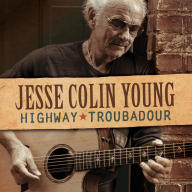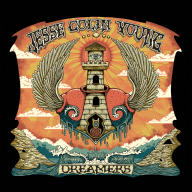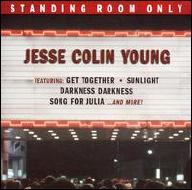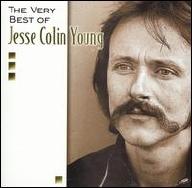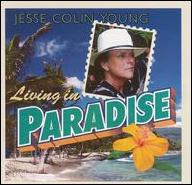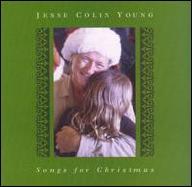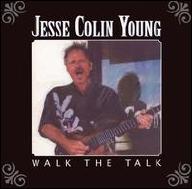Born Perry Miller in 1941, Young was raised in Long Island, New York where his mother was a violinist and his father worked as an accountant. Both parents shared a love of classical music and encouraged their son to play, giving him piano lessons from a young age. Following the family's move to Pennsylvania, 15-year-old Young enrolled at Phillips Academy Andover in Massachusetts where he took classical guitar as an elective. His musical interests soon overtook his other school studies as he eschewed homework to practice guitar and sing Everly Brothers songs with his roommate. He was ultimately expelled from the academy, and after finishing high school enrolled at Ohio State University. There, he lived behind a record store and further expanded his musical knowledge, digging deeper into folk, blues, and jazz artists. After a semester, he dropped out and after a few months of traveling across country, he returned to his parent's home in Bucks County, Pennsylvania where he spent a summer further honing his skills, diving deep into albums by Muddy Waters, John Lee Hooker, Lightnin' Hopkins, Joan Baez, and others.
By 1961 he had transferred to NYU and spent several years balancing his studies with playing gigs at local Greenwich Village coffeehouses. Dropping out of school, he took a day job working at the Rockefeller Foundation and continued playing solo folk shows. It was during this period that he was put in touch with producer Bobby Scott, who came to see him perform at Folk City in Greenwich Village. This led to a recording session at A&R Studio, out of which came Young's debut album, 1964's The Soul of a City Boy, released on Capitol. Prior to the album's release he had adopted the name Jesse Colin Young (an amalgamation of western outlaws Jesse James and Cole Younger, and Grand Prix racer Colin Chapman) to avoid undue comparisons to pop singer Perry Como. A stripped-down production of solo folk performances, The Soul of a City Boy included a cover of the George Remaily song "Four in the Morning," which gained radio airplay and helped launch Young's career. A second Scott-produced album, Young Blood, followed a year later on Mercury, which was then run by Quincy Jones. It featured a more fully realized production sound, including musical contributions by jazz artists like bassist George Duvivier and drummer Grady Tate, as well as harmonica playing by fellow rising folk star John Sebastian of the Lovin' Spoonful.
Around this time he met guitarist Jerry Corbitt while playing a show in Cambridge, Massachusetts. They began hanging out and working on music together. Inspired by the Beatles, and looking to move toward a more electrified sound, they joined forces with keyboardist/guitarist Lowell Banana Levinger and drummer Joe Bauer with Young moving to bass. Naming themselves the Youngbloods after Young's second album, they developed a rambling, harmony-laden sound that touched upon the blues, country, and lyrical folk-rock. Playing regularly at New York club The Night Owl, they gained valuable experience opening for a bevy of touring performers. They signed to RCA and released a debut single, Corbitt's ragtime-influenced "Grizzly Bear," which charted in the Top 60 in November 1966. Their full-length debut, The Youngbloods, followed in 1967 and featured their cover version of Dino Valenti's idealistic peace and love anthem "Get Together." Released as a single, "Get Together" also made the charts, landing at number 62 on the Hot 100. The group quickly followed up with a sophomore album, Earth Music.
By the time the band issued their third album, 1969's Charlie Daniels-produced Elephant Mountain, they had relocated to the San Francisco Bay Area. As they were beginning work on the album Corbitt dropped out of the band, leaving Young and Levinger as the primary songwriters and creative drivers of the group. Under Young's influence, the album found the Youngbloods exploring more of their jazz and Americana influences. There was also a more introspective tone to many of Young's songs, with tracks like "Darkness, Darkness" and "Quicksand" addressing themes of death and depression and evoking the war in Vietnam. At the same time in 1969, RCA re-released "Get Together" as a single after it was used in a public-service commercial for the National Council of Christians and Jews. It again boosted the band's profile, landing at number five on the Hot 100. The group also hit the singles charts with Young's songs "Sunlight" and "Darkness, Darkness."
In 1970, Young built a home and recording studio on a ridge top in Inverness, California where he recorded his third solo album, 1972's Together. Released on the Youngbloods' own Raccoon Records (distributed by Warner Bros), it showcased an easygoing mix of covers, including songs by Chuck Berry, Mississippi John Hurt, and Dave Dudley, as well as a few notable originals like the anti-war "Peace Song." The album marked the beginning of the end for the Youngbloods, who released their final studio albums, 1971's Good and Dusty and 1972's High on a Ridge, before calling it quits.
Signed to Warner Bros, Young moved forward as a solo artist, issuing 1973's jazz-infused Song for Juli. It found him working with his wife, singer/songwriter Suzi Young (with whom he co-wrote the title track about their daughter), as well as several of Van Morrison's associates including bassist David Hayes and saxophonist Jim Rothermel, as well as noted jazz trumpeter Tom Harrell. A creative and commercial breakthrough, the album hit number 51 on the Billboard Top 200 and helped solidify Young's return to solo work. More albums arrived in quick succession with 1974's Light Shine and 1975's Songbird hitting number 37 and 26, respectively, on the Top 100. He followed with 1976's On the Road and 1977's Love on the Wing, both of which charted in the Top 100. All of these albums showcased Young's continued interest in jazz, country, and soft rock idioms, as well as his ongoing concerns over the environment, social activism, and his home life.
Moving to Elektra, Young issued 1978's American Dreams, which included an ambitious six-part suite, as well as forays into disco. The following year he joined Crosby, Stills Nash, James Taylor, Jackson Browne, and others at Madison Square Garden for the No Nukes protest concert. He then returned to his studio work with 1982's rock- and adult contemporary-leaning The Perfect Stranger, which suffered from poor label promotion. Also during these years, Young and his wife Suzi divorced. Though he continued to tour in an acoustic format, he wouldn't return with another album until 1987's The Highway Is for Heroes, released on the short-lived Cypress Records. He also participated in several mid-'80s reunions of the Youngbloods with Corbitt and Levinger.
In the '90s, Young remarried and he and his wife launched their own Ridgetop Music label, releasing 1993's Makin' It Real and 1994's Swept Away. They also began reissuing many of his previous solo albums, but their work was disrupted in 1995 when their home was destroyed in the Mount Vision wildfire that swept through much of Point Reyes and Inverness Park. Thankfully, his studio was spared and he was able to salvage his recordings and resume his reissue campaign. After the fire, the couple relocated to Hawaii where they began running their own Kona coffee farm. More albums followed, including the 1996 live set Sweetwater, which found Young revisiting some of his favorite songs in an acoustic format.
Young stayed active in the new millennium, issuing a handful of laid-back albums like 2003's Walk the Talk and 2004's Living in Paradise. There was even the holiday-themed Songs for Christmas. Also during the mid-2000s, Young was diagnosed with Lyme Disease. He went on antibiotics and quit drinking at the same time, decisions that helped his recovery. In 2019, he issued Dreamers, recorded with producer Colin Linden (Bruce Cockburn, Sue Foley, Blackie the Rodeo Kings) and his son bassist Tristan Young. ~ Matt Collar, Rovi
|
1
|
|
Ridgetop |
|
2
|
|
Grey Day |
|
3
|
|
Morning Sun |


